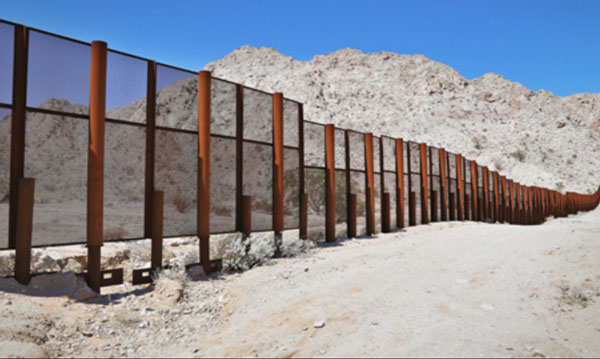
COMMENT | ALISON L LACROIX | By claiming that it has the power to enforce its own immigration policy, even when that policy conflicts with federal law, Texas has reignited a debate about federalism that is as old as the United States itself. But with so many commentators invoking the past to justify their positions, it is crucial to get the history right.
Many cite the Civil War as an analogy to – and a cautionary tale for – the current moment. But the more accurate benchmark is not the war itself; it is the five decades of simmering constitutional conflict that preceded the war’s outbreak. The similarities between those years and today should be a warning to us all. Demands for states’ rights are what Thomas Jefferson described (in 1820) as a “fire bell in the night,” threatening to sound the “knell of the Union.”
On the eve of the Civil War, US President Abraham Lincoln proclaimed in his first inaugural address that “the Union of these States is perpetual.” But he might well have said, “Conflict about the structure of the Union is perpetual”: so it had been ever since the Constitution’s drafters laid down their pens in 1787.
Between 1815 and 1861 – what I call the interbellum period – arguments about the nature of the Union dominated US political and legal debates. Americans, living under multiple governments, frequently talked (and sometimes fought) about which government had the power to tell them what to do, especially when it came to the issues of commerce, migration, and slavery.
Today we use the term federalism to refer to the relationship between the states and the national government. When the Constitution established the American version of federalism, the underlying idea was not new. It drew on European political theory and the colonists’ practical experience of living as subjects of the British Empire. What was novel was the embrace of multilayered government as an ideal, rather than as a defect. Founders such as James Madison saw a structure that was “partly federal and partly national” as the best means of achieving the goal of a “well constructed Union.”
Though the ideal of a federal union was compelling, the founders left its content unsettled. When Americans in the early nineteenth century started to argue about new political questions that seemed to implicate federalism, they could not look to the founders for clear, straightforward answers. The founders had bequeathed only an idea, which later generations would have to think through for themselves.
This was an era of rapid change. The US experienced a market revolution as transportation and trade networks expanded along with the country’s territory (and as indigenous nations and rival European powers were pushed out). While slavery became further entrenched in the South and ignited clashes over expansion to newly admitted western states, national institutions (such as the Bank of the United States, the post office, and the federal courts) stretched the ligaments of federal power more broadly – and more deeply into people’s everyday lives. Early-nineteenth-century Americans thus faced pressing problems for which their forebears had left only a sketchy map.
Many of the most significant interbellum constitutional debates were struggles about which government controlled overlapping domains of power. Moreover, interbellum Americans tended to regard this conflict as being consistent with the design of the system. “It must have been foreseen that controversies would sometimes arise as to the boundaries of the two jurisdictions,” wrote Virginia judge William H. Cabell in 1815, objecting to the Supreme Court’s efforts to overturn a decision of the state high court. “Yet the Constitution has provided no umpire, has erected no tribunal by which they shall be settled.”
The argument that a state had the power to determine for itself the boundaries between its jurisdiction and that of the federal government recurred throughout the early nineteenth century. Most famously, in 1832, South Carolina declared two of Congress’s tariff laws “null and void,” and forbade both state and federal officials from enforcing the acts “within the limits of this State.” The same ordinance also prohibited challenges to nullification that relied on appealing a case from the state’s highest court to the US Supreme Court. By declaring the congressional tariff laws void, barring enforcement by revenue officials, and prohibiting the Court’s review, nullification sought to cut the state loose from all three branches of the federal government.
Claims of states’ rights proliferated in the interbellum period, and not only as a means of advancing a proslavery agenda. In the 1840s and 1850s, northern and midwestern states invoked state sovereignty as a shield against the reach of Congress’s fugitive-slave laws. Massachusetts, Pennsylvania, and Wisconsin each passed “personal liberty” laws to protect Black residents from being forcibly removed.
In response to the fugitive-rendition process dictated by federal statute, these states explicitly positioned themselves as nullifiers. An 1854 Anti-Slave-Catchers’ Mass Convention in Milwaukee urged the formation of a “State League” to “defend our State Sovereignty, our State Courts, and our State and National Constitutions, against the flagrant usurpations of US Judges, Commissioners, and Marshals.” In an 1859 joint resolution, Wisconsin’s legislature insisted that the “rightful remedy” for “all unauthorized acts done or attempted to be done under the color of” the Constitution was “a positive defiance” by the sovereign states.
Though battles over the hierarchy of federal and state power were omnipresent in early-nineteenth-century US law and politics, there are two key differences between those struggles and current debates. First, interbellum conflicts were driven by structural disputes and sectional tensions, whereas those today are rooted in political partisanship.
Second, the constitutional era in which the interbellum clashes took place was fundamentally different from our own. Lincoln’s insistence that the Union was perpetual shaped what the Civil War would mean for him, his contemporaries, and all later generations. At the time, however, his assertion was only a hypothesis; not until the Confederacy’s defeat in 1865 did it become a fact. That is why we should see the history of the early nineteenth century as a cautionary tale. Reviving arguments that almost unraveled the Union is a deadly serious business.
*****
 Alison L. LaCroix, a former member of the Presidential Commission on the Supreme Court of the United States, is Professor of Law and an associate member of the History Department at the University of Chicago and the author of the forthcoming The Interbellum Constitution: Union, Commerce, and Slavery in the Age of Federalisms (Yale University Press, May 2024).
Alison L. LaCroix, a former member of the Presidential Commission on the Supreme Court of the United States, is Professor of Law and an associate member of the History Department at the University of Chicago and the author of the forthcoming The Interbellum Constitution: Union, Commerce, and Slavery in the Age of Federalisms (Yale University Press, May 2024).
Copyright: Project Syndicate, 2024.
www.project-syndicate.org
 The Independent Uganda: You get the Truth we Pay the Price
The Independent Uganda: You get the Truth we Pay the Price


